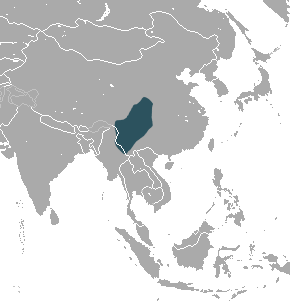
Moles are small mammals adapted to a subterranean lifestyle. They have cylindrical bodies, velvety fur, very small, inconspicuous eyes and ears, reduced hindlimbs, and short, powerful forelimbs with large paws adapted for digging.

The family Talpidae includes the moles who are small insectivorous mammals of the order Eulipotyphla. Talpids are all digging animals to various degrees: moles are completely subterranean animals; shrew moles and shrew-like moles somewhat less so; and desmans, while basically aquatic, excavate dry sleeping chambers; whilst the quite unique star-nosed mole is equally adept in the water and underground. Talpids are found across the Northern Hemisphere of Eurasia and North America, and range as far south as the montane regions of tropical Southeast Asia.

The shrew moles or shrew-like moles (Uropsilus) are shrew-like members of the mole family of mammals endemic to the forested, high-alpine region bordering China, Myanmar, and Vietnam. They possess a long snout, a long slender tail, external ears, and small forefeet unspecialized for burrowing. Although they are similar to shrews in size, external appearance, and, presumably, ecological habits, they are nevertheless talpids and considered true moles, as they share a full zygomatic arch with all other moles, while this arch is completely absent in shrews.

Yangchuanosaurus is an extinct genus of metriacanthosaurid theropod dinosaur that lived in China from the Middle to Early Cretaceous periods, and was similar in size and appearance to its North American and European relative, Allosaurus. Yangchuanosaurus hails from the Upper Shaximiao Formation and Suining Formation and was the largest predator in a landscape that included the sauropods Mamenchisaurus and Omeisaurus and the stegosaurs Chialingosaurus, Tuojiangosaurus and Chungkingosaurus. This theropod was named after the area in which was discovered, Yongchuan, in China.
A shrew mole or shrew-mole is a mole that resembles a shrew. Species with this name include:

Yandusaurus is a genus of herbivorous basal neornithischian dinosaur from the Bathonian age of China.
Gongxianosaurus is a genus of basal sauropod dinosaur from the early Jurassic Period. The only species is Gongxianosaurus shibeiensis. Based on four fragmentary to complete specimens found in China, it is one of the most completely known early sauropods. The skeleton is known in large part, missing both the hand and the majority of the skull. Gongxianosaurus was firstly named and described in a short note published in 1998; however, a comprehensive description has yet to be published. Gongxianosaurus shibeiensis was named for the place it was found, near the village Shibei in Gong County.

Wolong National Nature Reserve, also officially known as Wolong Special Administrative Region, is a protected area located in Wenchuan County, Sichuan Province, People's Republic of China.

The Gansu mole is a species of mammal in the family Talpidae endemic to central China, where it occurs in Shaanxi, Gansu, Sichuan, and Qinghai. It is the only species in the genus Scapanulus.

The long-tailed mole is a species of mole in the family Talpidae. It is found in China, Vietnam and Myanmar.

The Anderson's shrew mole is a species of mammal in the family Talpidae. It is endemic to China. Its species name "andersoni" was chosen to honor American scientific collector Malcolm Playfair Anderson.

The gracile shrew mole is a species of mammal in the family Talpidae. It is endemic to China; populations known from Myanmar likely represent other species.

The Chinese shrew mole is a species of mammal in the family Talpidae. It is endemic to China, Sichuan Province. Its natural habitat is temperate forests.

True's shrew mole is a species of mammal in the family Talpidae. It is endemic to Japan and is a common species above 1000 meters in grassland, shrubland and forest. Sometimes this species is called the lesser Japanese shrew mole and another species, Urotrichus talpoides, is called the "greater Japanese shrew mole".

The Scalopinae, or New World moles, are one of three subfamilies of the family Talpidae, which consists of moles and mole-like animals; the other two subfamilies being the Old World talpids and the Chinese shrew-like moles (Uropsilinae). The Scalopinae are the only Talpidae subfamily to consist entirely of undisputed moles and no mole-like close relatives such as shrew-moles or desmans.

Lingwulong is a genus of dicraeosaurid sauropod dinosaur from the Middle Jurassic of what is now Lingwu, Yinchuan, Ningxia, China. The type and only species is L. shenqi, known from several partial skeletons. It is the earliest-aged neosauropod ever discovered, as well as the only definite diplodocoid from east Asia.

Ognev's mole is a species of mammal in the family Talpidae. It occurs in the southeastern coastal area of the Black Sea from northeastern Turkey to Georgia. It inhabits different habitats associated with moist soils in lowland areas. Little information is available about its life history.
The Snow Mountain shrew mole is a species of mammal in the family Talpidae. It is native to Yunnan Province in China and potentially Myanmar. Its common name references Jade Dragon Snow Mountain, which is the type locality of the species. Aside from there, the only other confirmed specimen is from Cang Mountain.
The Dabie Mountains shrew mole is a species of mammal in the family Talpidae and genus Uropsilus. It is endemic to Anhui Province in China, where, as its name suggests, it is only known from the Dabie Mountains.
Mustela aistoodonnivalis, the missing-toothed pygmy weasel or Sichuan weasel, is a species of weasel that inhabits mountains in the Shaanxi and Sichuan provinces of China.














